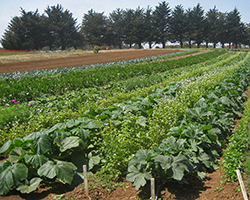What is regenerative agriculture?
That's a great question, and one that is becoming more and more important to understand. To start us off, let's think about a farm. After a long day, the sun sets over acres of farmland. The tractor rides stop for the day and the last bottles of apple cider are sold. It was a good day for this little farm. It produced healthy foods for its neighbors while treating the land well. Unlike most farms, this farm is working toward a more sustainable future. The farmers there use some old and some new methods that together take care of the farm's soils, while helping to reduce climate change. In doing this, the farmers can increase their crop while using less pesticides and store bought fertilizers.

One important part of a regenerative farming practice is to avoid planting monocultures. Monocultures are big areas where you only grow one (mono-) type of plant or crop. Instead, growing different plants in different rows helps make a more diverse garden, with fewer pest problems. Image of a diverse crop by David Silver via Wikimedia Commons.
Many farms all over the world are starting to use this type of farming - regenerative agriculture. Regenerative agriculture describes ways of farming that focus more on the well-being of the environment around the farm. Some of the ways we have farmed over the last 100 years can have many downsides. Many farmers till the soil between crops, use lots of pesticides, and grow one crop over a huge area of land. Those methods might decrease biodiversity (the variety of life), erode or remove good soils, pollute our lands and air, and use a lot of water. They also often release carbon from our soils, or create other gases that contribute to climate change.
Regenerative agriculture can help us try to reduce climate change. It uses technologies that result in healthier soil. This is important because soil quality impacts the nutritional value of food. Such methods can increase the number and type of plants being grown and lower carbon emissions.
Regenerative agriculture is a way of farming that uses many methods to reduce our impact on the land. Crop rotation is planting different crops on the same plot of land over a few growing seasons. It reduces water use and the need for pest control, and ultimately leads to healthier soil.

Tilling is a common practice that harms soils. Many farmers use special tractors that mix or till the dirt after they harvest a crop. This breaks up the soil structure and can increase erosion. Image by Walter Baxter via Wikimedia Commons.
No-till and low-till farming are also practices that reduce harm to soil. Practices like this reduce soil erosion, water use, and carbon release. Rotational grazing keeps farm animals from eating too many plants from one area, by moving them around to graze. This helps to prevent soil erosion. These are just a few of the regenerative agriculture practices that can be used to improve the land.
If we start using regenerative practices in place of the ways we’ve farmed for much of the last century, we can work to make our lands healthy again. This can help us to have thriving farms, communities, and ecosystems.
Close up image of barley by Hans via Pixabay.
Have a different answer or more to add to this one? Send it to us.
View Citation
Bibliographic details:
- Article: What is regenerative agriculture?
- Author(s): Dr. Biology
- Publisher: Arizona State University School of Life Sciences Ask A Biologist
- Site name: ASU - Ask A Biologist
- Date published: December 15, 2022
- Date accessed: April 19, 2024
- Link: https://askabiologist.asu.edu/questions/regenerative-agriculture
APA Style
Dr. Biology. (2022, December 15). What is regenerative agriculture?. ASU - Ask A Biologist. Retrieved April 19, 2024 from https://askabiologist.asu.edu/questions/regenerative-agriculture
Chicago Manual of Style
Dr. Biology. "What is regenerative agriculture?". ASU - Ask A Biologist. 15 December, 2022. https://askabiologist.asu.edu/questions/regenerative-agriculture
Dr. Biology. "What is regenerative agriculture?". ASU - Ask A Biologist. 15 Dec 2022. ASU - Ask A Biologist, Web. 19 Apr 2024. https://askabiologist.asu.edu/questions/regenerative-agriculture
MLA 2017 Style

In many countries, we are farming in ways that are not healthy for our land. We use too many pesticides and too many machines, we grow crops in a way that attracts pests, and we waste AND pollute our water. What can we do to improve our practices and keep our lands healthier?
Be Part of
Ask A Biologist
By volunteering, or simply sending us feedback on the site. Scientists, teachers, writers, illustrators, and translators are all important to the program. If you are interested in helping with the website we have a Volunteers page to get the process started.






